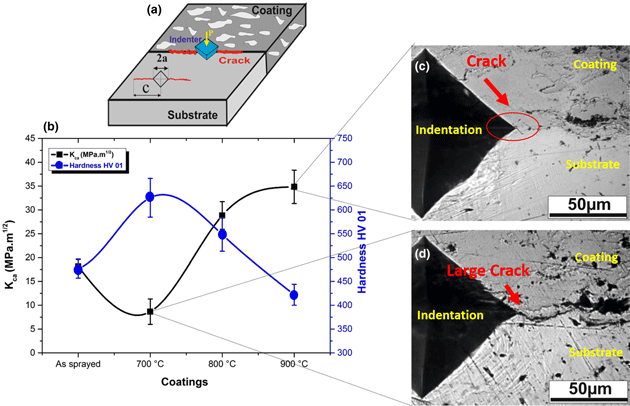Crossref Citations
This article has been cited by the following publications. This list is generated based on data provided by
Crossref.
Mazouzi, Azzeddine
Rezzoug, Amine
Cheniti, Billel
Lebouachera, Seif El Islam
Miroud, Djamel
Boukantar, Aniss-Rabah
Drouiche, Nadjib
and
Djerdjare, Boubekeur
2021.
Impact of wear parameters on NiCr-WC10Co4Cr and WC10Co4Cr HVOF sprayed composite coatings using response surface methodology.
The International Journal of Advanced Manufacturing Technology,
Vol. 114,
Issue. 1-2,
p.
525.
2022.
Zhu, Zi-wei
Chen, Qing-Yu
Bai, Xiao-Bo
Yang, Chao
Ji, Gangchang
Zhang, Meng-Xian
Wang, Hong-Tao
Yao, Hai-Long
and
Wang, Fang
2022.
Microstructure, Phase Constitution and Mechanical Properties of Wc-Cr3c2-Conila Coatings Fabricated by Using Hvof Spraying Core-Shell Powder.
SSRN Electronic Journal ,
Zhu, Zi-wei
Chen, Qing-Yu
Bai, Xiao-Bo
Yang, Chao
Ji, Gang-Chang
Zhang, Meng-Xian
Wang, Hong-Tao
Yao, Hai-Long
and
Wang, Fang
2022.
Microstructure, phase constitution and mechanical properties of WC-Cr3C2-CoNiLa coatings fabricated by using HVOF spraying core-shell powder.
International Journal of Refractory Metals and Hard Materials,
Vol. 106,
Issue. ,
p.
105862.
Zhang, Ziying
Lei, Shengyuan
Xie, Xiaomeng
Yan, Zhibin
Li, Weizhou
and
Zhao, Xiaolian
2023.
Influence of vacuum heat treatment on wear behavior of HVAF sprayed WC-Cr3C2–Ni coatings.
Vacuum,
Vol. 216,
Issue. ,
p.
112431.
Morales, Cindy
Fortini, Annalisa
Soffritti, Chiara
and
Merlin, Mattia
2023.
Effect of Post-Fabrication Heat Treatments on the Microstructure of WC-12Co Direct Energy Depositions.
Coatings,
Vol. 13,
Issue. 8,
p.
1459.
Zhang, Li
Li, Shengli
Zhang, Chunlin
Ai, Xingang
and
Xie, Zhiwen
2023.
Microstructure and Mechanical and Impact Behaviors of WC-Particle-Reinforced Nickel-Based Alloy Surfacing Layers at Evaluated Temperatures.
Metals,
Vol. 13,
Issue. 5,
p.
961.
Chen, Xinxue
Li, Chang
Li, Siyu
Han, Xing
Jiang, Haisheng
and
Zhao, Xiaoyu
2023.
HVOF Spray Performance Optimization Analysis and Experimental Research of WC–12Co Coating on Ti Alloy.
Metals and Materials International,
Vol. 29,
Issue. 12,
p.
3548.
Jiang, Haisheng
Zhao, Xiaoyu
Song, Hua
and
Li, Chang
2023.
The Effect of High-Velocity Air-Fuel WC-12Co Coatings on the Wear and Corrosion Resistance of TC18 Titanium Alloy.
Coatings,
Vol. 13,
Issue. 4,
p.
755.
Liang, Xinghua
Zhuang, Tong
Lan, Lingxiao
Huang, Jian
Li, Siying
Lei, Yunsheng
Xu, Bohan
Wang, Yujiang
Shi, Xueli
and
Hu, Qicheng
2024.
Study on Wear and Scour Performance of Ni6035WC/Wc-10Cr-4Cr Coating by HVAF.
Coatings,
Vol. 14,
Issue. 9,
p.
1148.
Zhang, Diyao
Qu, Sheng
Peng, Zijun
Liu, Zhenli
Yu, Jingkun
and
Yuan, Lei
2024.
Effect of aged treatment on improving the performance of HVAF WC–Cr3C2–Ni coating on crystallization roller.
Engineering Fracture Mechanics,
Vol. 312,
Issue. ,
p.
110640.
Hebib, Malek
Choukrane, Lilia
Cheniti, Billel
Faghi, Lotfi
Kovalčíková, Alexandra
Bouchafaa, Hamida
Maamache, Bouzid
Csanádi, Tamás
and
Hvizdoš, Pavol
2024.
Recovery of metal matrix composite drilling tools using a WC-Ni/Cr TIG-hardfacing technology.
Wear,
Vol. 540-541,
Issue. ,
p.
205273.
Eriş, Rasim
Meghwal, Ashok
Singh, Surinder
Berndt, Christopher C.
Ang, Andrew Siao Ming
and
Munroe, Paul
2025.
Annealing effects on the microstructural and mechanical evolution of high-velocity oxygen-fuel (HVOF) sprayed Al0.3CrFeNiTi0.3 medium-entropy alloy coatings.
Surface and Coatings Technology,
Vol. 502,
Issue. ,
p.
131805.
Macknojia, Ali
Dockins, Maddox
Ayyagari, Aditya
Montoya, Vanessa
Rodriguez, James
Cairns, Euan
Murthy, Nikhil
Berkebile, Stephen
Voevodin, Andrey
Aouadi, Samir
and
Berman, Diana
2025.
Tribological Evaluation of Coatings in Fuel Environments.
Journal of Tribology,
Vol. 147,
Issue. 7,
Wang, Xingxing
Qu, Qingbo
Zhang, Xinmei
Pan, Kunming
Ling, Zicheng
Wang, Pei
Shi, Jianjun
Peng, Yan
Chen, Xiaoming
Zhang, Lei
Zhang, Yulei
and
Yin, Shuo
2025.
Methods and insights in optimizing nickel-based coatings for wear and corrosion resistance.
Materials Today Communications,
Vol. 43,
Issue. ,
p.
111793.
Zhou, Qiong
Wang, Tao
Huang, Biao
Zhang, Er-geng
Chen, Qiang
Liang, Dan-dan
Wang, Zhan-yong
Ke, Han-yin
and
Chen, Rui-dong
2025.
Effects of high-temperature atmospheric annealing on surface microstructure of CrTiSiN coating.
Vacuum,
Vol. 234,
Issue. ,
p.
114064.




